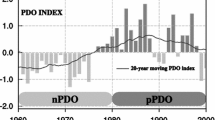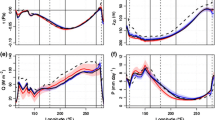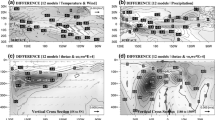Abstract
In this study, we use the Bjerknes stability (BJ) index as a tool to investigate overall El Niño-Southern Oscillation (ENSO) stability in a hybrid-coupled model (HCM) with various atmosphere and ocean background states. This HCM shows that ENSO growth rates as measured by the BJ index and linear growth rates estimated directly with a time series of the Niño 3.4 indices from the coupled model simulations exhibit similar dependence on background states, coupling strength, and thermodynamic damping intensity. That is, the BJ index and linear growth rates increase with a decrease in the intensity of the background wind, an increase in coupling strength, or a decrease in the intensity of thermodynamic damping, although the BJ index tends to overestimate the growth rate. A detailed analysis of the components of the BJ index formula suggests the importance of model climatological background states and oceanic dynamic parameters in determining ENSO stability. We conclude that the BJ index may serve as a useful tool for qualitatively evaluating the overall ENSO stability in coupled models or in observations without a detailed eigen-analysis that is difficult to perform in models more complex than relatively simple models.












Similar content being viewed by others
References
AchutaRao K, Sperber KR (2006) ENSO simulation in coupled ocean-atmosphere models: are the current models better? Clim Dyn. doi:10.1007/s00382-006-0119-7
An S-I (2008) Interannual variations of the tropical ocean instability wave and ENSO J Clim 21:3680–3686
An S-I (2009) A review of interdecadal changes in the nonlinearity of the El Nino-Southern Oscillation. Theor Appl Climatol 92:29–40
An S-I, Jin F-F (2000) An eigen analysis of the interdecadal changes in the structure and frequency of ENSO mode. Geophys Res Lett 27:1573–2576
An S-I, Jin F-F (2001) Collective role of thermocline and zonal advective feedbacks in the ENSO mode. J Clim 14:3421–3432
An S-I, Wang B (2000) Interdecadal change of the structure of the ENSO mode and its impact on the ENSO frequency. J Clim 13:2044–2055
An S-I, Jin F-F, Kang IS (1999) The role of zonal advection feedback in phase transition and growth of ENSO in the Cane–Zebiak model. J Meteorol Soc Jpn 77:1151–1160
Barnett TP, Graham N, Pazan S, White W, Latif M, Flügel M (1993) ENSO and ENSO-related predictability. Part I: prediction of equatorial Pacific sea surface temperature with a hybrid coupled ocean-atmosphere model. J Clim 6:1545–1566
Battisti DS, Hirst AC (1989) Interannual variability in a tropical atmosphere-ocean model: influence of the basic state, ocean geometry and nonlinearity. J Atmos Sci 46:1687–1712
Bejarano L, Jin F-F (2008) Coexistence of equatorial coupled modes of ENSO. J Clim 21:3051–3067
Bretherton CS, Smith C, Wallace JM (1992) An intercomparison of methods for finding coupled patterns in climate data. J Clim 5:541–560
Cane MA, Sarachik ES (1977) Forced baroclinic ocean models, Part II: The linear equatorial bounded case. J Mar Res 35:395–432
Cane MA, Münnich M, Zebiak SF (1990) A study of self-excited oscillations of the tropical ocean-atmosphere system. Part I: linear analysis. J Atmos Sci 47:1562–1577
Capotondi A, Wittenberg A, Masina S (2006) Spatial and temporal structure of tropical Pacific interannual variability in 20th century coupled simulations. Ocean Model 15:274–298
Clarke AJ, Lebedev A (1996) Long-term changes in equatorial Pacific trade winds. J Clim 9:1020–1029
Davey MK et al (2002) STOIC: a study of coupled model climatology and variability in tropical ocean regions. Clim Dyn 18:403–420
Fedorov AV, Philander SGH (2000) Is El Niño changing? Sci 288:1997–2002
Fedorov AV, Philander SGH (2001) A stability analysis of tropical ocean-atmosphere interactions: Bridging measurements and theory for El Niño. J Clim 14:3086–3101
Guilyardi E, Wittenberg A, Fedorov A, Collins M, Wang C, Capotondi A, van Oldenborgh GJ, Stockdale T (2009) Understanding El Niño in ocean-atmosphere general circulation models: progress and challenges. Bull Am Meteorol Soc 90:325–340
Held IM, Soden BJ (2006) Robust responses of the hydrological cycle to global warming. J Clim 19:5686–5699
Hirst AC (1986) Unstable and damped equatorial modes in simple coupled ocean-atmosphere models. J Atmos Sci 43:606–630
Jin F-F (1997a) An equatorial ocean recharge paradigm for ENSO. Part I: conceptual model. J Atmos Sci 54:811–829
Jin F-F (1997b) An equatorial ocean recharge paradigm for ENSO. Part II: a stripped-down coupled model. J Atmos Sci 54:830–847
Jin F-F, An S-I (1999) Thermocline and zonal advective feedbacks within the equatorial ocean recharge oscillator model for ENSO. Geophys Res Lett 26:2689–2992
Jin F-F, Neelin JD (1993) Modes of interannual tropical ocean-atmosphere interaction—a unified view part I: numerical results. J Atmos Sci 50:3477–3502
Jin F-F, Kim ST, Bejarano L (2006) A coupled-stability index of ENSO. Geophys Res Lett 33:L23708. doi:10.1029/2006GL027221
Kalnay E et al (1996) The NCEP/NCAR 40-year reanalysis project. Bull Am Meteorol Soc 77:437–471
Legler DM, O’Brien JJ (1985) Atlas of tropical Pacific wind-stress climatology: 1971–1980. Florida State University, Tallahassee, p 187
Levitus S (1982) Climatological atlas of the world ocean. NOAA Prof. Pap. 13. US Government Printing Office, Washington, DC, p 173
Levitus S, Burgett R, Boyer T (1994) World Ocean Atlas 1994 Volume 3: Salinity. NOAA Atlas NESDIS 3. US Department of Commerce, Washington, DC, p 113
MacMynowski DG, Tziperman E (2008) Factors affecting ENSO’s period. J Atmos Sci 65:1570–1586
Merryfield WJ (2006) Changes to ENSO under CO2 doubling in a multimodel ensemble. J Clim 19:4009–4027
Münnich M, Cane MA, Zebiak SE (1991) A study of self-excited oscillations of the tropical ocean–atmosphere system. Part II: nonlinear cases. J Atmos Sci 48:1238–1248
Neelin JD (1990) A hybrid coupled general circulation model for El Niño studies. J Atmos Sci 47:674–693
Neelin JD, Dijkstra HA (1995) Ocean-atmosphere interaction and the tropical climatology. Part I: the dangers of flux correction. J Clim 8:1325–1342
Otto-Bliesner BL, Brady EC, Shin S-I, Liu Z, Shields C (2003) Modeling El Niño and its tropical teleconnections during the last glacial-interglacial cycle. Geophys Res Lett 30:L2198. doi:10.1029/2003GL018553
Pacanowski RC, Griffies SM (1998) MOM 3.0 Manual. NOAA/Geophysical fluid dynamics laboratory, 668 pp
Pacanowski RC, Philander SGH (1981) Parameterization of vertical mixing in numerical models of the tropical oceans. J Phys Oceanogr 11:1443–1451
Philander SGH (1981) The response of equatorial oceans to a relaxation of the trade winds. J Phys Oceanogr 11:176–189
Philander SGH, Pacanowski RC (1986) A model of the seasonal cycle in the tropical Atlantic Ocean. J Geophys Res 91:14192–14206
Philander SGH, Yamagata T, Pacanowski RC (1984) Unstable air-sea interaction in the tropics. J Atmos Sci 41:604–613
Smith TM, Reynolds RW (2003) Extended reconstruction of global sea surface temperatures based on COADS data (1854–1997). J Clim 16:1495–1510
Syu H-H, Neelin JD, Gutzler D (1995) Seasonal and interannual variability in a hybrid coupled GCM. J Clim 8:2121–2143
Tang Y (2002) Hybrid coupled models of the tropical Pacific: I interanuual variability. Clim Dyn 19:331–342. doi:10.1007/s00382-002-0230-3
Timmermann A (2001) Changes of ENSO stability due to greenhouse warming. Geophys Res Lett 28:2061–2064
Timmermann A, Justino F, Jin F-F, Krebs U, Goose H (2004) Surface temperature control in the North and tropical Pacific during the last glacial maximum. Clim Dyn 23:353–370. doi:10.1007/s00382-004-0434-9
Vecchi GA, Soden BJ (2007) Global warming and the weakening of the tropical circulation. J Clim 20:4316–4340
Vecchi GA, Soden BJ, Wittenberg AT, Held IM, Leetmaa A, Harrison MJ (2006) Weakening of tropical Pacific atmospheric circulation due to anthropogenic forcing. Nature 441:73–76
Zebiak SE, Cane MA (1987) A model El Niño-southern oscillation. Mon Weather Rev 115:2262–2278
Acknowledgments
This research is supported by NSF grants ATM 0652145 and ATM 0650552 and NOAA grants GC01-229. The authors thank Drs. Eric Guilyardi, Axel Timmermann and Shang-Ping Xie and anonymous reviewers for their valuable comments and May Izumi for her careful editing of the manuscript.
Author information
Authors and Affiliations
Corresponding author
Rights and permissions
About this article
Cite this article
Kim, S.T., Jin, FF. An ENSO stability analysis. Part I: results from a hybrid coupled model. Clim Dyn 36, 1593–1607 (2011). https://doi.org/10.1007/s00382-010-0796-0
Received:
Accepted:
Published:
Issue Date:
DOI: https://doi.org/10.1007/s00382-010-0796-0




